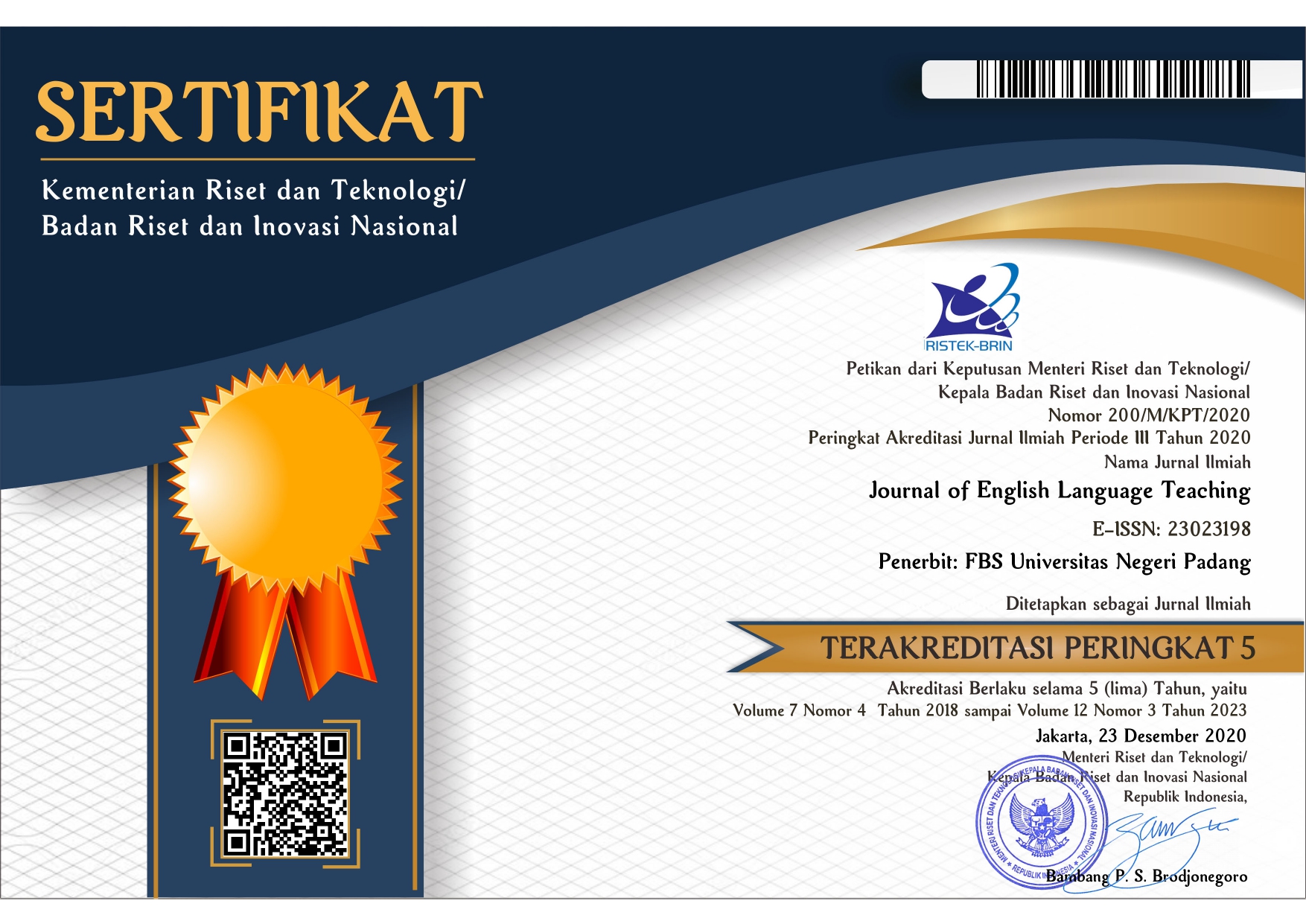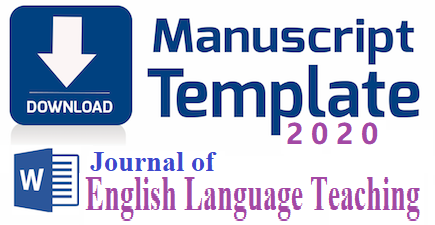EFL College Student’s Perception in Using Movie Animations from Little Fox Youtube Channel as Autonomous Learning Activities
 ), Leni Marlina(2),
), Leni Marlina(2), (1) Universitas Negeri Padang
(2) Universitas Negeri Padang
 Corresponding Author
Corresponding Author
Copyright (c) 2024 Nadafa Namira Zahra
DOI : https://doi.org/10.24036/jelt.v13i1.127554
Full Text:
 Language : en
Language : en
Abstract
References
Abdel Razeq, A. A. (2014). University EFL learners’ perceptions of their autonomous learning responsibilities and abilities. RELC Journal, 45(3), 321-336.
Andricos, A. R., & Marlina, L. (2023). The Effect of Using Digital Children’s Literature on Storybookscanada. ca To Students’ Vocabularies at SMAN 5 Padang. Journal of English Language Teaching, 12(4),
Balbay, S., & Kilis, S. (2017). Students' Perceptions of the use of a YouTube channel specifically designed for an Academic Speaking Skills Course. Eurasian Journal of Applied Linguistics, 3(2). Turkey.
Brown, H. D. & Abeywickrama, P. (2010). Language assessment: principles and classroom practice (2nd ed.). New York: Pearson Education Inc.
Cohen, L., Manion, L., & Morrison. (2007). Research Methods in Education - 6e | Louis Cohen, Lawrence Manion, Keith Morrison | digital library Bookfi. http://en.bookfi.net/book/1403129 (Retrieved on September, 30)
Creswell, J. W. (2013). Research Design: Qualitative, Quantitative, and Mixed Methods Approaches (Issue 1). SAGE Publications, Inc. Los Angeles.
Dang, T. (2012). Learner autonomy: A synthesis of theory and practice. The Internet Journal of Language, Culture, and Society, 35(1), 52-67. Vietnam.
Dewi, P. M. O., Artini, L. P., & Padmadewi, N. N. (2021). Self-directed Learning in EFL During COVID-19 Pandemic: An Analysis of Teacher's Perception and Students' Learning Autonomy in SMA N 1 Blahbatuh. Jurnal IKA, 19(1), 46-57.
Dhamayanti, F. I. (2021). EFL students’ perception and motivation toward Quizizz as e-learning media in English e-classroom. Education of English as Foreign Language, 4(2), 71-78.
Gardner, R. C., Allen, E. D., & Lambert, W. E. (1974). Attitudes and Motivation in Second-Language Learning. Hispania, 57(1), 193. https://doi.org/10.2307/339475. London.
Goksu, A. (2015). HIGH SCHOOL STUDENTS’PERCEPTIONS OF CLASSROOM LEARNING ENVIRONMENTS IN AN EFL CONTEXT. Revista de Cercetare şi Intervenţie Socială, (51), 72-89.
Hafner, C. & Miller, L. (2011). Fostering learner autonomy in English for science: A collaborative digital video project in a technological learning environment. Language Learning & Technology Journal, 15(3), 68-86. doi: 10125/44263
Jafari, S., Ketabi, S., & Tavakoli, M. (2017). Advanced and intermediate EFL learners’ perceptions and practices of autonomous learning. ITL-International Journal of Applied Linguistics, 168(1), 70-90.
Katchen, J. E. (1995). How to use cartoons in the EFL classroom. Thai TESOL Bulletin, 8(1), 32-39.
Khaidir, F., Tersta, F. W., & Afria, R. (2020). Students’ perception of autonomous learning activities. J-SHMIC: Journal of English for Academic, 7(1), 66-76.
Khulaifiyah, K., Widiati, U., Anugerahwati, M., & Suryanti, N. (2021). Autonomous learning activities: The perceptions of English language students in Indonesia. Pegem Journal of Education and Instruction, 11(3), 34-49.
Knuuttila, S., & Karkkäinen, P. (2008). Theories of Perception in Medieval and Early Modern Philosophy. Springer Science + Business Media B.V. Finland
Liando, N. V., Sahetapi, R. J., & Maru, M. G. (2018). English major students’ perceptions towards watching English movies in listening and speaking skills development.
Long, T., Logan, J., & Waugh, M. (2016). Students’ perceptions of the value of using videos as a pre-class learning experience in the flipped classroom. TechTrends, 60, 245-252.
Lynch, T., & Mendelsohn, D. (2013). Listening. In An introduction to applied linguistics (pp. 190-206). Routledge.
Mandasari, B., & Aminatun, D. (2022). INVESTIGATING TEACHERS’BELIEF AND PRACTICES TOWARD DIGITAL MEDIA OF ENGLISH LEARNING DURING COVID-19 PANDEMIC. English Review: Journal of English Education, 10(2), 475-484.
Mardjuki, M. S. (2018). Learner autonomy: Gender-based perception among EFL Indonesian students. Indonesian Journal of EFL and Linguistics, 3(1), 1.
Marsevani, M. (2021). LEARNERS’PERCEPTION AND PRACTICES ON AUTONOMOUS LANGUAGE LEARNING IN EFL SETTINGS. International Journal of Language and Literature, 5(1), 54-65.
Masykuri, E. S., & Basuki, B. (2022). Students’ perception of digital media for English teaching learning. Teaching English as a Foreign Language Journal, 1(1), 64-73.
May, J. P. (1995). Children's literature and critical theory: Reading and writing for understanding.. New York: Oxford University Press
Meidasari, V. E. (2017). The using of digital media to enhance teaching and learning English on the well-being of Indonesian students. Journal of English Language and Culture, 6(1).
Melvina, M., Lengkanawati, N. S., & Wirza, Y. (2021). Autonomous Learning: Indonesian University Learners’ Perception. Journal of Hunan University Natural Sciences, 48(11).
Melvina, M., Lengkanawati, N. S., & Wirza, Y. (2021). Autonomous Learning: Indonesian University Learners’ Perception. Journal of Hunan University Natural Sciences, 48(11).
Miller, C. (2020). Perception Process. Exploring Communication in the Real World. Hong Kong
Nugroho, A., & Atmojo, A. E. P. (2020). Digital learning of English beyond classroom: EFL learners’ perception and teaching activities. JEELS (Journal of English Education and Linguistics Studies), 7(2), 219-243.
Nugroho, A., & Atmojo, A. E. P. (2020). Digital learning of English beyond classroom: EFL learners’ perception and teaching activities. JEELS (Journal of English Education and Linguistics Studies), 7(2), 219-243.
Qiong, O. U. (2017). A brief introduction to perception. Studies in Literature and Language, 15(4), 18-28. China.
Rebecca, J. L. (2006). Critical Handbook of Children's Literature. Allyn & Bacon. Readings on Children’s Literature
Riasati, M. J. (2012). EFL learners’ perception of factors influencing willingness to speak English in language classrooms: A qualitative study. World Applied Sciences Journal, 17(10), 1287-1297.
Robbins, S. P., & Judge, T. A. (2014). Essentials of Organizational Behavior (12th ed.). Pearson Education, Inc.
Rost, M. (2013). Teaching and researching: Listening. Routledge.
Rukmana, G. W. (2021). Students’ perception toward the use of Google Classroom as teaching and learning English media for EFL students. Journal of Educational Study, 1(2), 110-119.
S. Egoff., S. Gordon., A. Ralph & S. Wendy Readings on Children’s Literature. New York: Oxford University Press
Saeed, M. A. (2021). Learner autonomy: learners’ perceptions on strategies to achieve autonomy in an EFL classroom. International Journal of Linguistics, Literature and Translation, 4(3), 150-158.
Silviyanti, T. M. (2014). Looking into EFL students’ perceptions in listening by using English movie videos on YouTube. Studies in English language and Education, 1(1), 42-58.
Thompson, D. B. K., & Bordwell, D. (1997). Film Art. USA.
Utami, N. W. S. (2021). Students’ Perception On Animated Film As A Media To Teach Writing Narrative Text. Widyalaya: Jurnal Ilmu Pendidikan, 2(1), 58-68. Jakarta.
Ware, P., Liaw, M. L., & Warschauer, M. (2012). The use of digital media in teaching English as an international language. Principles and practices for teaching English as an international language, 67, 84.
 Article Metrics
Article Metrics
 Abstract Views : 137 times
Abstract Views : 137 times
 PDF Downloaded : 39 times
PDF Downloaded : 39 times
Refbacks
- There are currently no refbacks.
Copyright (c) 2024 Nadafa Namira Zahra

This work is licensed under a Creative Commons Attribution-NonCommercial 4.0 International License.
















